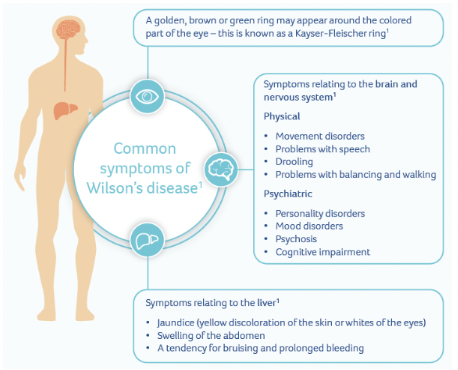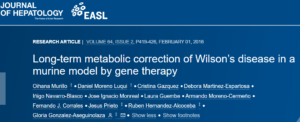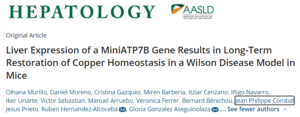Wilson’s disease at a glance

Wilson disease (WD) is an orphan, inherited, progressive and severely debilitating disorder of copper metabolism which is lethal if left untreated.
Cause :
Wilson disease is associated with tissue accumulation of copper, as a result of mutations in the ATP7B copper transporter. ATP7B has 2 central roles in copper metabolism :
- Excretion of excess copper from hepatocytes into the bile ducts
- Loading of copper ions into ceruloplasmin, and subsequent secretion into the blood circulation
INHERITANCE :
Wilson disease is inherited in an autosomal recessive manner, which means that each patient has received one copy of the mutated ATP7B gene from each parent.
ATP7B transporter deficiency results in tissue accumulation of very toxic “free” (unbound to ceruloplasmin) copper, mainly in the liver and the CNS.

The disease affects approx. one in 30,000 people worldwide


MAIN SYMPTOMS :
Patients affected with Wilson disease remain asymptomatic for years until the first symptoms manifest, typically during the 2nd or 3rd decade of life. They can initially present with hepatic, neurological or psychiatric symptoms, or a combination of all three.


Hepatic manifestations
at presentation are very variable and patients may present with asymptomatic transaminase elevation, chronic hepatitis, cirrhosis or, in the most severe cases, acute liver failure (that may be associated with hemolytic anemia)

Neurogical symptoms
may include movement and posture impairment (tremor, choreiform movements, parkinsonism, gait disturbances, rigid dystonia, seizures), speech impairment (dysarthria, pseudobulbar palsy), migraines, headaches and/or insomnia.

are also very variable and nonspecific and may encompass depression, neuroses, personality changes or psychosis. An additional symptom, Kayser-Fleischer rings (brown discoloration encircling the iris), is highly evocative of Wilson disease but not always present.
Diagnosis :
CURRENT TREATMENT OPTIONS :
All patients diagnosed with Wilson’s Disease must be treated for life to prevent the development of severe neuropsychiatric and hepatic complications.

Medical intervention – general principle
In general, the treatment follows 2 phases : – “Decoppering phase” for 6-12 months using copper chelators (mainly D-penicillamine or trientine) to reduce accumulated copper by increasing urinary copper excretion, – “Maintenance phase” to maintain acceptable copper levels using either reduced doses of copper chelators or zinc salts (zinc reduces intestinal dietary copper absorption). Occasionally, coper chelators and zinc may be used in combination. Zinc salts may also be used directly in some pre-symptomatic patients. Current medical treatments are constraining since they must be taken 3-4 times/day for life, at specific times away from meals, and may also be associated with significant side effects.A GUIDE TO WILSON’S DISEASE
This leaflet will provide you with information about Wilson’s disease, including symptoms, causes and current treatments. This leaflet is not intended as a substitute for professional medical advice. Always seek the advice of your physician or another qualified health provider.UNMET MEDICAL NEEDS

POTENTIAL BENEFITS OF AAV GENE THERAPY, AS A NOVEL APPROACH TO MANAGE WILSON DISEASE
Correction by gene therapy of the defective ATP7B transporter function may ultimately bring a cure to patients with Wilson disease.
The goal of gene therapy is to overcome the main limitations of current management by
– Restoring physiological copper metabolism
– Providing long-lasting benefits with a single intravenous vector administration, alleviating the need for multiple daily administration of current treatments and their associated side effects and therefore optimizing adherence to treatment
– Preventing disease complications (neurological deterioration, psychiatric manifestations and progressive liver diseases) and outweighing significant current therapy costs
Publications:
Long-term metabolic correction of Wilson’s disease in a murine model by gene therapy
A GUIDE TO GENE THERAPY
This leaflet will provide you with information about what gene therapy is, how it works and how it might help someone who has a genetic disease. This leaflet is not intended as a substitute for professional medical advice. Always seek the advice of your physician or another qualified health provider







